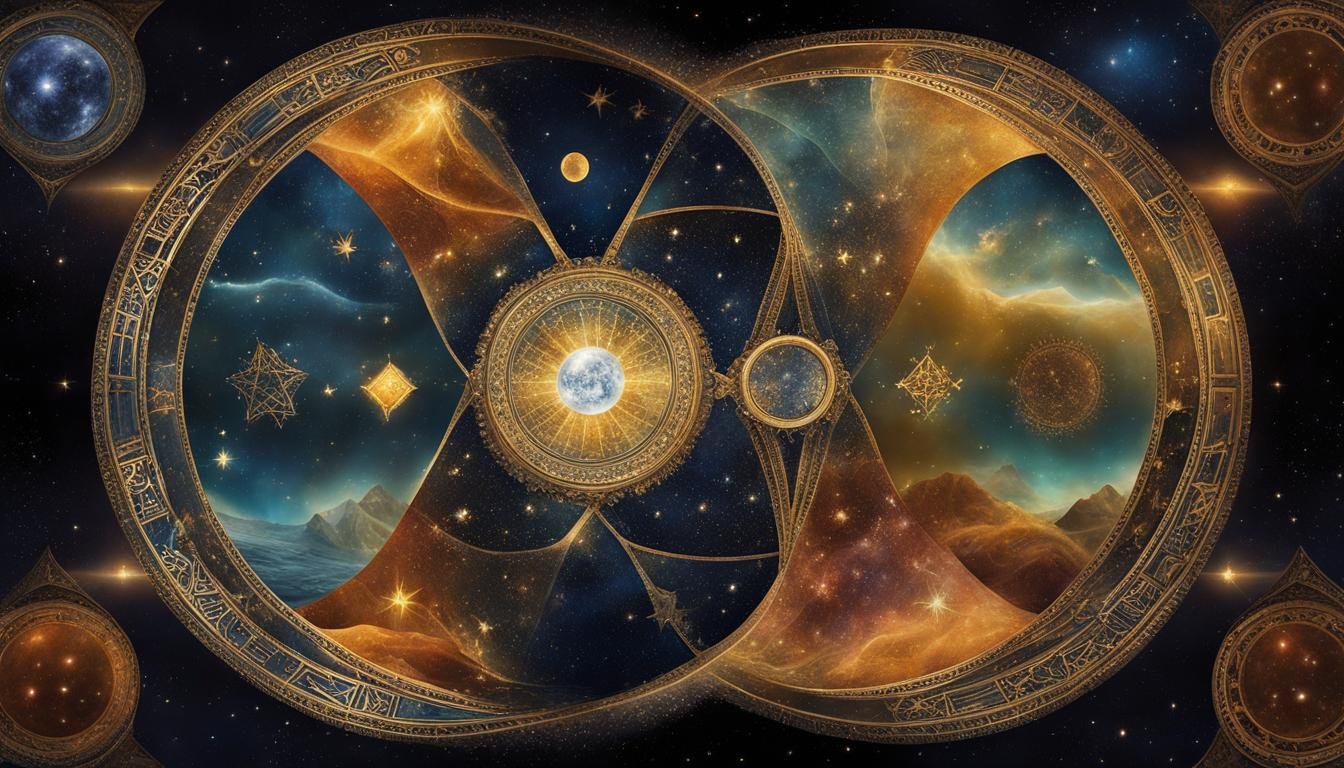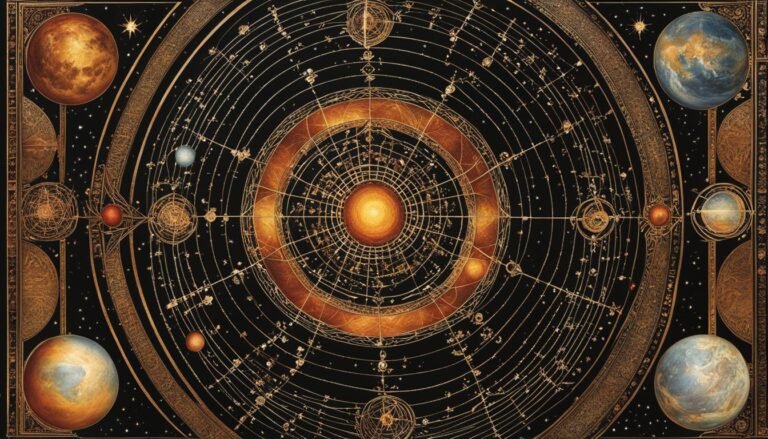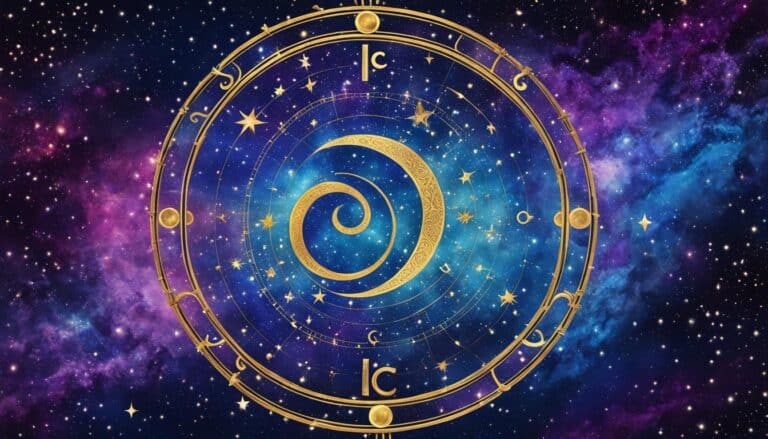What Does Cusp Mean In Astrology?
Have you ever felt like you don’t quite fit the mold of your zodiac sign? Perhaps you’re on the brink, where the qualities of two signs seem to merge. Exploring the astrological cusp meaning might shed light on why. In the realm of astrology, the concept of being on the “cusp” involves dates when the sun transitions from one sign to the next. It’s a period that intrigues many, leading to the idea that your personality could be influenced by not just one, but a blend of zodiac energies.
But here’s where it gets interesting: Traditional astrology cusp explanation doesn’t necessarily uphold the notion of hybrid signs. The truth is, the sun occupies only one zodiac sign at a time, according to specific degrees on your natal chart. So, while the expression ‘born on the cusp’ is commonly thrown around, its technical use might differ from the popular belief shared among astrology enthusiasts. The real story behind zodiac cusps definition doesn’t hinge on a blending of signs but rather the intricate dance of celestial bodies and their degrees during your birth.
Key Takeaways
- “Cusp” in astrology refers to the dates when the sun shifts from one sign to another, potentially imbuing individuals with mixed traits.
- Despite common beliefs, hybrid zodiac signs are not recognized in astrological practices based on precise degrees on the birth chart.
- The perceived personality blend when born on a cusp may stem more from neighboring planets than the sun sign itself.
- Understanding the astrological cusp meaning sheds light on why you might resonate with two zodiac signs.
- For a true astrology cusp explanation, consulting an accurate natal chart to see planetary alignments is key.
Exploring the Concept of Zodiac Cusps
Have you ever felt you don’t fit perfectly into your zodiac sign? Maybe you’re born on the edge of two constellations and you’re trying to understand cusp signs and their influence in astrology. Fear not, as we delve into the significance of cusp astrology and unravel common misunderstandings surrounding it.
Defining the Astrological Cusp
An astrological cusp is a term used to describe the very end of one zodiac sign and the beginning of another. It is often mistaken for a mix of traits from two separate signs. Yet, in actuality, your true zodiac sign is determined by the exact position, the precise degree, of the Sun at the time of your birth. For those intrigued by the mystical cosmos, understanding cusp signs takes us on a journey beyond traditional sun sign astrology.
The Significance of Cusp Dates in Astrology
While the astrological community may debate the impact of cusp dates, their significance can’t be overlooked. If you’re born within a few days of the sun transitioning from one sign to the next, you might identify with traits from both, fueled by the sun’s concluding energy in one sign and the emerging essence of another. Yet, don’t be misled into thinking this means you own a blend of two sun signs; rather, it’s a testament to the rich tapestry of your individual astrological profile.
Common Misconceptions About Cusp Signs
- Point one: Cusp signs are not officially recognized in astrology due to the Sun inhabiting one sign at any given time.
- Point two: The belief in possessing a combination of characteristics from two zodiac signs persists despite the lack of a degree-based foundation.
- Point three: Personal identification with cusp traits may actually be influenced by other planetary positions in your birth chart, not a dual sun sign.
As we explore the fabric woven by the stars, it’s key to appreciate the complexity and precision inherent in astrology. By realizing the significance of cusp dates in astrology and setting aside misconceptions, your celestial insights will become infinitely richer.
Astrological Cusp Traits and Personalities
If you’re intrigued by the concept of zodiac cusps in astrology, you might find it fascinating that those born on the brink of two zodiac signs often feel a sense of shared identity between the neighboring signs. It’s important to recognize that from an astrological standpoint, **astrological cusp traits** are less about straddling two distinct sun signs and more about the nuanced influence of celestial positioning on your birth chart.
For example, if your birthday falls on the cusp of Aquarius and Pisces, you might notice you possess a duality in your character—amalgamating the forward-thinking air sign’s cerebral prowess with the deep-feeling water sign’s empathetic tendencies. However, it’s your sun sign’s precise degree at the time of your birth that truly shapes your astrological identity, not a blend of two. This sun sign is defined by the zodiac constellations as they were positioned the moment you took your first breath.
- Intellectual Aquarius could bring innovative thinking and humanitarian concerns.
- Intuitive Pisces might infuse your nature with creativity and deep emotional insights.
- The dynamic synergy of these influences is unique to each individual, rather than a cookie-cutter crossing of sign boundaries.
The magnetic allure of having multifaceted personalities due to zodiac cusps in astrology is a topic that both captivates and confounds. It’s essential to delve beyond surface interpretations and appreciate that the astrological chart’s richness comes from many intricate parts working together, creating a symphony that is your distinct self.
Remember, the intriguing part of being born near a zodiac cusp isn’t about being split between two worlds—it’s about the potential to harness the spectrum of traits offered by your unique cosmic blueprint. So, if you’ve ever wondered about the cosmic forces that make you quintessentially “you”, consider a deep dive into the specific degrees of your natal chart—the answers might just be written in the stars.
What Does Cusp Mean in Astrology?
When you delve into the nuances of astrology, the term astrological cusp may come up, prompting the question, “what does cusp mean in astrology?” For those who were born close to when the Sun transitions from one zodiac sign to another, the concept of a cusp sign can be particularly intriguing. The popular belief proposes that if you’re born on a cusp, you possess a blend or hybrid of characteristics from both adjacent zodiac signs. This idea is akin to having the best of both worlds, combining the traits of two astrological archetypes into one unique profile.
However, professional astrologers often clarify this common misconception. In technical astrological terms, a cusp doesn’t signify a mix of two signs. The Sun can only be in one place in the sky, hence occupying a single zodiac sign. This placement is determined by the specific degree within a sign at your exact time of birth. Consequently, the technical astrological cusp sign interpretation does not support the idea of a hybrid sign but rather references the precise location of the Sun in your natal chart.
This nuanced understanding can lead to a profound appreciation for the intricate nature of astrology, encouraging you to explore your own birth chart with a more discerning eye. So, while the term ‘cusp’ may carry a different meaning in everyday discussions, arm yourself with this deeper knowledge to navigate astrological conversations with clarity and confidence.
The Debate Among Astrologers on Cusp Validity
When you delve into the complexities of astrology, you’ll discover that cusp signs stir up quite the conversation. Some astrologers are staunch in their stance that cusps simply do not exist, while others consider the influence of cusp signs to be a meaningful aspect of astrological interpretation. This dichotomy in beliefs highlights the ongoing debate about the astrological cusp sign interpretation and the variety of astrology cusp explanation methods employed by different practitioners.
Understanding the Position of Planets and Degrees
The argument often boils down to technical details regarding the sun’s position and its degrees. While some accuse the cusp concept of being a generalization that undermines precise astrological methods, proponents argue that adjacent sign traits noticeable in individuals can be explained through the positioning of influential planets. As Mercury and Venus make their dance around the Sun, their transits might pepper one’s personality with adjacent zodiac sign features, which might be mistakenly attributed to a cusp.
Different Interpretations Within the Astrology Community
Your encounter with astrology and its interpretation of cusps may vary greatly depending on which astrologer you consult. One may tell you that your natal chart points to a singular zodiac sign defined by exact degrees, squashing any ideas of cusp-related identities. Another might invite you to explore how the movements and positions of personal planets at your time of birth could afford you traits often associated with neighboring signs, therefore granting credibility to the concept of cusps in a non-traditional sense.

The exploration of astrology, much like the universe itself, is vast and filled with varying interpretations. While the debate on cusp sign validity continues, it opens up the opportunity for you to engage with astrology on a deeper level, inviting a more personalized understanding of how the stars can illuminate the many facets of your identity.
Identifying Your Unique Cusp Position
Are you intrigued by the concept of the astrological cusp? If you’ve ever wondered whether you were born on one of these cusps, you’re certainly not alone. The astrology cusp explanation revolves around the idea that at the moment of your birth, the Sun was transitioning from one zodiac sign to another—hence the term cusp. However, to truly understand this, you need to delve into the astrological cusp meaning by considering the precise degree of the Sun at your time of birth.
To start deciphering your unique cusp position, it’s important to look at your full birth chart, which is like a cosmic snapshot of all the planets at the moment you came into the world. This chart provides deeper insights into not just your Sun sign but also how the other celestial bodies contribute to your personality and life path. If other planets in your natal chart were positioned in the sign next to your Sun sign, they might indeed blend or shade your sun sign traits with flavors from the neighboring sign.
To gain a clear picture of your astrological identity, you might consider these actionable points:
- **Obtain your full birth chart:** An in-depth analysis goes beyond your Sun sign and explores other significant planetary positions.
- **Examine the degree of your Sun sign:** Knowing whether it’s at the very beginning, the middle, or the end of the sign can provide valuable context.
- **Look at adjacent sign influences:** The planets close to the Sun, like Mercury or Venus, can impact your identification with cusp-related traits.
Remember, the journey to astrological cusp meaning is a personal one, and while astrology can provide overarching themes, your individual experiences and choices color the complete portrait of who you are.
Embracing the nuances of astrology can help you appreciate the complexity and beauty of your unique astrological blueprint. Now, go on and explore the cosmic interplay of forces that have left their imprint on you from the very moment you entered this world!
Personal Planets and Their Influence on Cusp Signs
Have you ever felt like your astrological profile doesn’t quite fit the mold of your sun sign? Maybe you exhibit qualities that resonate with a neighboring sign, and you can’t help but wonder why. Let’s delve into how the personal planets, particularly Mercury and Venus, play a pivotal role in this astrological phenomenon and influence the astrological cusp traits that you might identify with.
Mercury, Venus, and the Cusp Effect
These two celestial bodies are known as personal planets due to their close orbit to the Sun, and therefore closely influence your core self. Mercury governs communication and thinking processes, while Venus is all about love, values, and relating to others. Imagine them as cosmic neighbors, influencing the energy of your Sun sign if you’re born on the cusp—the days where one sign transitions to the next.
How Personal Planets Affect Perceived Cusp Traits
Mercury and Venus often find themselves in a different zodiac sign than the Sun, which can significantly affect your personality. If your Mercury or Venus is in the sign next to your Sun sign, you might feel a blend of characteristics from both signs. This influence gives credence to the idea of cusp signs and explains why you might feel a connection to the traits typically associated with being on the cusp.
- Feel more communicative and curious than your Sun sign suggests? Check where Mercury was at your birth.
- Relating to others in a way that seems at odds with your Sun sign? Venus might just be in a neighboring sign adding its flair to your approach to love and beauty.
Understanding the influence of personal planets on cusp signs offers you an enriched perspective of your astrological blueprint, providing a more nuanced reflection of your individuality.
Characterizing Each Zodiac Cusp
As you delve into the realm of astrology, understanding the zodiac cusps definition unearths a fascinating facet of your celestial blueprint. Each cusp mirrors a distinctive energy, shaped by the merger of traits from adjacent zodiac signs. This synergy endows you with nuanced characteristics that may differ from the generalized descriptions of your sun sign alone.
Cusp of Sensitivity: Aquarius-Pisces
If your birthdate hovers on the cusp between Aquarius and Pisces, you are enshrouded by the Cusp of Sensitivity. This means you might possess Aquarius’ progressive mind and Pisces’ empathetic heart, a blend that equips you for both innovative thinking and deep emotional connections.
Cusp of Rebirth: Pisces-Aries
Those born under the Cusp of Rebirth, where the mystical waters of Pisces flow into the fiery realm of Aries, often exhibit an intriguing fusion of contemplation and action. Your astrological cusp traits may include Pisces’ imaginative reverie balanced by the assertive vigor of Aries—a pairing that can be as complex as it is compelling.
Cusp of Energy: Taurus-Gemini, and More
The Cusp of Energy breathes life into those born as Taurus prepares to hand the reins over to Gemini. If this is your cusp, you might find yourself grounded in Taurus’s earthen stability while also animated by Gemini’s airy sociability. This vibrant combination fuels your resilience and wit, enabling you to navigate life’s rhythms with both patience and curiosity.
Myth vs. Reality: The Truth About Cusp Astrology
When you dive into the world of astrology, you’ll often encounter the fascinating concept of zodiac cusps in astrology. While the idea of being born on the brink of two zodiac signs sounds intriguing, it’s important to distinguish the significance of cusp astrology from common myths. Contrary to popular belief, the truth about cusp astrology doesn’t revolve around a magical blend of sign traits. Instead, it’s about understanding the nuanced impact of specific planetary positions on your personality.
Let’s unravel the myth that cusps create a hybrid zodiac sign. In reality, the Sun can only be in one sign at any given time. If your birthday falls close to the transition of two signs, you may indeed relate to traits from both, but this alignment is less about the Sun’s position and more about the subtle influence of other celestial bodies surrounding your sun sign.
Perhaps you’ve felt a resonance with the neighboring sign’s characteristics? The detailed analysis of your birth chart can reveal why. It exposes the complexity of astral influences beyond the simplistic definition of cusp signs. Personal planets like Mercury and Venus often inhabit the sign just before or after your Sun sign, leading to this perceived overlap in traits.
- Understanding the role of personal planets in shaping your zodiac identity
- Decoding the true influence of the Sun’s degree in your birth chart
- Embracing the detailed complexity of celestial impacts, well beyond cusp astrology
Engaging with the actual astrological practice allows you to appreciate the intricate tapestry of cosmic influences unique to you, something far richer than the cusp myth. Grasping the reality of your natal chart’s indications brings clarity to the significant and authentic experiences of your life, as aligned with the stars.

The Role of Birth Charts in Cusp Sign Interpretation
When delving into the astrology of cusp signs, the birth chart serves as a definitive guide to understanding your personal celestial imprint. This intricate map captures the exact positions of all planetary bodies at the moment of your birth, painting a comprehensive picture of your astrological profile. The birth chart analysis looks well beyond just your sun sign, considering other pivotal components that personalize your astrological interpretation and explain the nuanced traits you may associate with cusp dates in astrology.
Components of a Birth Chart
Your birth chart is comprised of several astral elements, each contributing to your unique characteristics. Among these are:
- The Moon Sign, shaping your emotional landscape and inner self.
- The Rising Sign (or Ascendant), influencing how the world perceives you.
- The positions of personal planets like Mercury, Venus, and Mars, each governing different facets of personality, including communication, love, and action.
The Sun Sign’s Relationship with Moon and Rising Signs
Your sun sign is often seen as the core of your astrological identity, providing a broad stroke of your ego and will. Yet, it doesn’t stand alone. The moon and rising signs add texture and depth to the picture. Through in-depth birth chart analysis, you gain insight into how the sun sign harmonizes or contrasts with the moon and rising signs, offering a complex and complete vision of your astrological essence, especially if you were born around cusp dates in astrology.
A Closer Look at Astrological Cusp Sign Interpretation
Delving deeper into your astrological profile may lead you to ponder the impact of being born on a cusp. If you’ve ever felt torn between two zodiac signs or experienced traits that resonate with both, the explanation lies in the subtlety of astrological cusp sign interpretation. This exploration illuminates the nuanced tapestry of your personality anchored in the stars.
Assessing the Energy of Your Sun Sign’s Degree
Understanding astrology demands a look beyond mere sun sign identification. Each zodiac sign encompasses 30 degrees within the 360-degree astrological chart, and your sun sign’s degree speaks volumes about the sway it holds in your life. At the onset (0 degrees), the sign’s influence is fresh, potent, and untainted, whereas at its closing (29 degrees), it holds the culmination of all its traits—a rich compendium of experiences waiting to transition to the next sign. This degree is not merely a number; it carries the vibrational energy that colors the canvas of your talents, challenges, and life approach.
How Cusp Period Traits Differ from Pure Sun Sign Traits
Those born during the cusp period possess a riveting blend of characteristics influenced by neighboring signs. Yet, to think of cusp period traits as a simple merger would fail to recognize the complexity of astrology. Unlike those with a sun sign positioned firmly within its designated zodiac range, cusp-born individuals often find themselves straddling two worlds. Just as the waning moments of twilight blend day into night, so too does the cusp period blend qualities of adjacent zodiac signs. But it’s important to note that this mixture of attributes is more than an overlay; it’s an interplay of various factors in your astrological chart, giving a personalized account of who you are.
Embracing your sun sign’s degree and recognizing how cusp period traits enrich your astrological narrative allows for a more personalized and profound comprehension of your being. As the cosmos cast its dance across the sky at your birth, you received a unique imprint of celestial energies—ones that ensure you are more than just a textbook representation of a sun sign.
Calculating the Sun’s Degree: A Guide for Cusp Individuals
Have you ever felt torn between two zodiac signs, as if your personality is a tapestry woven from the threads of adjacent astrological energies? Understanding how to calculate the Sun’s degree in your birth chart is essential for individuals born on the brink of a zodiac transition. This knowledge opens the door to discovering whether you possess characteristics of a cusp — a term with various interpretations in the astrology community. Here’s an insightful guide:
- Locate Your Birth Chart: Your journey begins by obtaining your natal chart from a reputable astrology site or professional astrologer. This chart is the celestial snapshot of the skies at the exact moment of your birth.
- Identify the Sun’s Position: Look for the symbol of the Sun in your birth chart. The degree next to this symbol is key to pinpointing your astrological identity.
- Determine Your Sun Sign: Each zodiac sign covers 30 degrees of the celestial wheel. If the degree of your Sun is between 0 and 29, it will correspond to a particular sign.
But what if your Sun is at the end of one sign or the very beginning of another? This is where the nuances come into play:
- If your Sun is between 27 to 29 degrees of one sign, you’re at the twilight phase of that sign’s influence, brimming with its fullest potentials and preluding the next sign’s energies.
- Conversely, if the Sun is 0 to 1 degree into a sign, you’re experiencing the dawn of its traits — a fresh perspective bearing the sign’s nascent qualities.
This gray zone — often misconstrued as a ‘cusp’ — doesn’t dilute your sun sign but rather enriches it with a subtle blend of the adjacent sign’s essence. Mastery over your birth chart highlights the complexity that makes you uniquely you, without confining you to the ‘cusp’ label. Embrace the intricacies of your astrological blueprint and celebrate the diverse aspects of your personality.
Conclusion
The exploration of astrological cusps throughout this article has shed light on the nuances and complexities of astrological identity. By delving into technical definitions, personal planet influences, and the crucial role of birth charts, you have gained a more comprehensive understanding of what it means to be born on the cusp of two zodiac signs. It’s evident that the sun’s specific degree at your time of birth casts a significant impact on your astrological profile, challenging the common yet oversimplified interpretations of cusps in astrology.
Embracing the Complexity of Your Astrological Identity
Your journey through the stars is uniquely your own, and whether or not you identify with cusp traits, embracing the entirety of your astrological makeup can be empowering. As you’ve learned, the position of the sun at your birth tells only part of the story. Your full natal chart, with its interplay of personal planets and degrees, provides invaluable insights into the rich tapestry of your personality and potential.
Finding Clarity in the Cusp Conversation
Understanding the influence of cusps can lead to clarity and a more personalized connection with astrology. Remember that astrology is not just about where the sun was when you were born but also how the other celestial bodies contribute to your character. With this knowledge, you can navigate the cusp conversation with confidence, knowing that the significance of cusp astrology is not in a binary label but in the profound discovery of your cosmic fingerprint.
FAQ
What does “cusp” mean in astrology?
In astrology, a “cusp” refers to the time period when the Sun transitions from one zodiac sign to the next. It is commonly thought that individuals born during this time may exhibit traits from both signs. However, in professional astrology, a person’s sun sign is determined by the exact degree the Sun was in at the time of birth, rather than a mix of two signs.
How do astrological cusp dates impact personality?
Astrological cusp dates are thought to impact personality by attributing a mixture of traits from two adjoining signs to those born during these periods. However, astrologers emphasize that personality traits are more accurately determined by a detailed birth chart analysis, considering exact placements of the Sun and other planets, rather than just cusp dates.
Are the traits of individuals born on the cusp a blend of two zodiac signs?
While popular astrology may suggest that individuals born on a cusp have a blend of traits from two zodiac signs, professional astrologers clarify that the Sun can only occupy one sign at a time. Any perceived overlap in personality traits is more likely due to the influence of other planets in a person’s birth chart, such as Mercury or Venus, which may be positioned in the neighboring sign.
Is there a debate among astrologers about the validity of cusps?
Yes, there is some debate among astrologers about the validity of cusps. Some deny their existence based on the premise that the Sun occupies a specific degree within one sign at any given time. Others acknowledge that the proximity of personal planets to the Sun at the time of birth could result in blended characteristics, reflecting the influence of adjacent signs.
How can I identify my unique cusp position?
To accurately identify your unique cusp position, you’ll need to look at your full birth chart, particularly the exact degree of the Sun at the time of your birth. This precise information will reveal whether neighboring signs’ influences are present in your personality, based on the broader context of your sun sign’s degree and the placements of other planets.
What role do personal planets like Mercury and Venus play in cusp signs?
Mercury and Venus play a crucial role in cusp signs as they often reside within the adjacent sign of one’s Sun sign, due to their close orbit around the Sun. These personal planets, which govern aspects of intellect, values, and communication, can influence an individual to embody characteristics from a neighboring sign, contributing to what is often referred to as the cusp effect.
How are zodiac cusps characterized?
Each zodiac cusp is characterized by a unique name and energy that captures the essence of the adjacent signs’ transition. These names often reflect the imagined blend of traits, like the Cusp of Sensitivity (Aquarius-Pisces) or the Cusp of Energy (Taurus-Gemini), though these are not recognized in formal astrological practice as actual hybrid signs.
What is the difference between myth and reality in cusp astrology?
The myth in cusp astrology is the belief that people born on a cusp are a hybrid of two zodiac signs. The reality, according to astrological theory, is that cusps don’t produce a hybrid sign; rather, one’s personality is impacted by the specific degree of the Sun and other planets at the time of birth. Detailed birth chart analysis is essential to understand the real influences at play.
What is covered in a birth chart analysis concerning cusp signs?
A birth chart analysis concerning cusp signs will cover the exact position of the Sun by degree and sign at the moment of birth, including the relationships between the Sun sign and the moon sign, rising sign, and other personal planets. This comprehensive analysis helps to unpack the unique interplay of celestial influences that influence one’s personality beyond the oversimplified concept of cusps.
How does a sun sign’s degree influence cusp period traits?
A sun sign’s degree, which can range from 0 to 29 within a particular zodiac sign, influences cusp period traits by marking the evolution of the sign’s characteristics. Those born at the beginning of a sign (0 degrees) may embody the purest form of its qualities, while those at the end (29 degrees) may experience a culmination of the sign’s traits. The specific degree helps determine an individual’s unique expression of their sun sign and can explain variances in traits associated with cusp periods.







